Click on images to enlarge
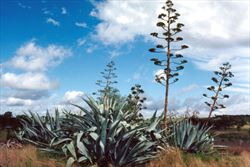
infestation (Photo: Land Protection, QDNRW)
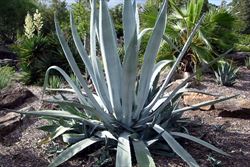
habit (Photo: Sheldon Navie)

habit in flower (Photo: Sheldon Navie)
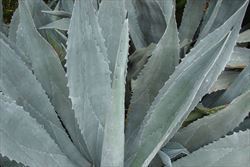
the large, greyish-green, fleshy leaves (Photo: Forest and Kim Starr, USGS)
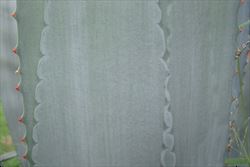
close-up of a leaf showing the prickles on its margins (Photo: Sheldon Navie)
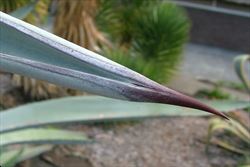
the large dark brown spine, which is borne on each leaf tip (Photo: Sheldon Navie)

the massive branched flower clusters (Photo: Sheldon Navie)
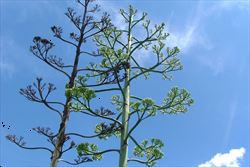
old and young flower clusters (Photo: Sheldon Navie)
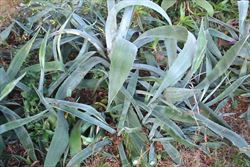
young plants forming a dense colony (Photo: Sheldon Navie)
Scientific Name
Agave americana L.
Three separate taxa are sometimes recognised in Australia:
Agave americana L. var. americanaAgave americana L. var. expansa (Jacobi) GentryAgave americana L. 'Marginata'
Synonyms
For Agave americana var. expansa:
Agave expansa Jacobi
For Agave americana 'Marginata':
Agave americana L. var. marginata
Agave americana L. var. picta (Salm-Dyck) A. Terrac.
Agave picta Salm-Dyck
Family
Agavaceae
Common Names
agave, agave cactus, aloe, American agave, American aloe, century plant, century-plant, maguey
Origin
Native to northern and central Mexico and some parts of southern USA (i.e. Arizona and Texas).
Cultivation
Century plant (Agave americana) is widely cultivated in Australia, especially in drier inland districts. In the early years of settlement it was sometimes grown as a hedge. This species is also widely cultivated in other parts of the world, and its leaves are sometimes used medicinally or grown for their fibres.
Several varieties and cultivars of this species may be seen in cultivation in Australia. The most common of these is probably variegated century plant (Agave americana 'Marginata'), but Agave americana 'Mediopicta' is also relatively common.
Naturalised Distribution
Century plant (Agave americana) is naturalised in many parts of Australia, but has a somewhat scattered distribution. It has been recorded from many parts of Queensland, Western Australia, New South Wales, the ACT, Victoria and south-eastern South Australia. It is also naturalised on Lord Howe Island and Norfolk Island. Because it is very difficult to collect, herbarium records probably greatly underestimate the actual distribution of this species in Australia. Possibly also naturalised in Tasmania and the Northern Territory.
Two varieties (i.e. Agave americana var. americana and Agave americana var. expansa) and one cultivar (i.e. Agave americana 'Marginata') have been recorded amongst naturalised populations in Australia. Some state herbaria do not distinguish between these taxa, so the actual ditributions of different varieties is not well known.
This species is also naturalised in many other parts of the world, including Europe, the Canary Islands, southern China, southern Africa and New Zealand.
Habitat
This species is often naturalised around old habitations and along roadsides in temperate, sub-tropical and semi-arid regions. However it also grows in pastures, grasslands, open woodlands, coastal environs and along watercourses.
Habit
A very large and long-lived (i.e. perennial) rosette-forming plant, growing 1-2 m high and 2-4 m across. Older individuals may sometimes develop a short woody stem at the base of the plant and commonly produces numerous suckers which form a large clump or colony. When fully mature, century plant (Agave americana) develops a massive flower cluster on a robust flowering stem 6-12 m tall.
Distinguishing Features
-
a long-lived plant forming clumps of leaves 1-2 m high and 2-4 m across.
-
its very large leaves (1-2 m long and 15-25 cm wide) are somewhat fleshy and are sometimes bent backwards near their tips.
-
these leaves are normally bluish-grey to greyish-green in colour, but forms with variegated leaves are relatively common.
-
the leaf margins are coarsely toothed, with prickly teeth, and the leaves end in a large dark-brown spine (1.5-6 cm long).
-
when fully mature this plant develops a massive much-branched flower cluster on a robust flowering stem 6-12 m tall.
-
its upright flowers (7-10.5 cm long) are yellow or greenish-yellow in colour and have six very prominent stamens.
-
its fruit are large capsules (3.5-8 cm long) that eventually split open to release their seeds.
Stems and Leaves
The stems of this plant are very short and woody. However, massive flowering stems are eventually produced. These are green or greyish green with alternately arranged bract-like leaves.
The very large leaves at the base of the plant are long and narrow (i.e. lanceolate) and arranged in a rosette. They may be upright (i.e. erect or ascending) or spreading in nature, and are sometimes bent backwards near their tips (i.e. reflexed towards the apex). These leaves (1-2 m long and 15-25 cm wide) are usually rigid and somewhat fleshy (i.e. succulent). They are normally bluish-grey (i.e. glaucous) to greyish-green in colour, but forms with variegated leaves are relatively common. The leaf margins coarsely toothed (i.e. serrate), with prickly teeth (up to 1 cm long) borne at intervals of 2-6 cm. The leaves have a pointed tip (i.e. acute apex) topped with a large dark-brown coloured spine (1.5-6 cm long).
Flowers and Fruit
The massive flower clusters (1-8 m long) are borne at the top of a very robust flowering stem. These flower clusters are much-branched, with the branches being further divided towards their tips (i.e. they are terminal panicles). Individual flowers are borne in an upright (i.e. erect) position on stalks (i.e. pedicels) 2-4 cm long. These flowers (7-10.5 cm long) are yellow or greenish-yellow in colour with their six 'petals' (i.e. perianth segments or tepals) being fused together at the base into a short tube (8-20 mm long). The flowers also have six very prominent stamens, consisting of stalks (i.e. filaments) 6-10 cm long and yellow anthers (2.5-3.5 cm long). They also have a large ovary (3-4.5 cm long) topped with a style and three stigmas. Flowering occurs from summer through to autumn.
The fruit is a large oblong capsule (3.5-8 cm long) with a pointed tip (i.e. beaked apex) and consists of three compartments. These capsules turn from green to brown or blackish in colour as they mature and eventually split open to release their seeds. The seeds (6-8 mm long) are black in colour and shiny in appearance.
Reproduction and Dispersal
This species produces seed, but it mainly reproduces itself vegetatively via suckers.
This plant spreads laterally via suckers and can form very large and dense colonies over time. Young plants produced in this manner can be dispersed downstream during floods. The seeds are also dispersed by both wind and water. Plants are most commonly spread into bushland areas in dumped garden waste.
Environmental Impact
Century plant (Agave americana) is regarded as an environmental weed in Victoria, New South Wales, South Australia, Western Australia and Queensland, and as a potential environmental weed or "sleeper weed" in the Northern Territory. It was recently listed as a priority environmental weed in at least one Natural Resource Management region and is thought to pose a significant threat to rangeland biodiversity in Australia. Though this species grows and spreads slowly, and is largely seen as an invader of roadsides and disturbed sites, it is also found growing in natural vegetation and eventually forms dense almost impenetrable thickets.
Century plant (Agave americana) is certainly taken seriously in New South Wales, where it appears on numerous local and regional environmental wed lists (e.g. in Warringah Shire, Randwick City, Blue Mountains City, the Sydney North region, the wider Sydney and Blue Mountains region and the NSW North Coast region). It is regarded as a threat to coastal environs in New South Wales and is present in national parks and conservation areas in the Far South Coast Region of this state (e.g. in several areas within the Southern Foreshore Reserve at Narrawallee Beach and subject to a control program in Ben Boyd National Park and Bellbird Creek Nature Reserve).
In Queensland, century plant (Agave americana) appears on the list of the top 200 most invasive plants in south-eastern Queensland and is listed as a high priority environmental weed in the Noosa Shire. This species is also listed as an invasive garden plant in the Greater Adelaide region and is known to be a serious coastal weed in South Australia. It has also been recorded in conservation areas in this state (e.g. Anstey Hill Recreation Park, Agery Reserve and Clinton Conservation Park) and the infestation in Clinton Conservation Park, on the Yorke Peninsula, is noted to be spreading through coastal shrubland where it is displacing native saltbushes, grasses and samphires.
Century plant (Agave americana) has also been recorded in conservation areas in Victoria and appears on several environmental weed lists in this state (e.g. in Banyule City, Moyne Shire, Nillumbik Shire and the Goulburn Broken Catchment). It is also seen as a potential weed threat in the Katherine region in the Northern Territory. While century plant (Agave americana) is not seen as a significant threat in Western Australia, it occupies valleys between sand dunes and limestone ridges and grows in disturbed natural vegetation in this state. It has also been actively controlled in Francois Peron National Park and other conservation areas in the Shark Bay region, where it is not yet widely established.
Other Impacts
The prickles along the leaf margins and sharp spines on the tips of the leaves can cause injury to people and animals (both domestic livestock and native animals). Large clumps can have an impact on pastures, as these dense colonies can prevent the growth of more suitable species and restrict the access of livestock.
Legislation
This species is not declared or considered noxious by any state or territory government in Australia.
Management
For information on the management of this species see the following resources:
- the Randwick City Council environmental weeds profile on this species, which is available online at http://www.randwick.nsw.gov.au.
Similar Species
Three forms of this species are known to be naturalised in Australia. They can be distinguished by the following differences:
- Agave americana var. americana has bluish-grey or greyish green leaves that are often bent backwards at their tips (i.e. they are reflexed). The spines at the tips of its leaves are relatively large (3-5 cm long).
- Agave americana var. americana 'Marginata' has variegated leaves (i.e. they are green with yellowish margins) that are often bent backwards at their tips (i.e. they are reflexed). The spines at the tips of its leaves are relatively large (3-5 cm long).
- Agave americana var. expansa has bluish-grey or greyish green leaves that are mostly borne upright (i.e. they are rarely reflexed). The spines at the tips of its leaves are relatively small (2-3 cm long).
Century plant (Agave americana) may be easily confused with the sisals (i.e. Agave sisalana and Agave angustifolia) and the false agaves (i.e. Furcraea foetida and Furcraea selloa). These species can be distinguished by the following differences:
- century plant (Agave americana) has very large greyish or variegated leaves that are usually 1-2 m long on adult plants. These leaves have numerous, relatively large prickles (5-10 mm long) along their margins. Its flowers are borne in an upright position and are yellow or yellowish-green in colour. This species produces large capsules and usually doesn't develop plantlets (i.e. bulbils) on the branches of its flower clusters.
- sisal (Agave sisalana) has relatively large dark green or greyish-green leaves that are usually 0.5-1.3 m long on adult plants. These leaves do not have any prickles on their margins. Its flowers are borne in an upright position and are yellow or yellowish-green in colour. This species usually doesn't produce capsules, instead developing numerous plantlets (i.e. bulbils) on the branches of its flower clusters.
- Caribbean agave (Agave angustifolia) has relatively large green, greyish-green or variegated leaves that are usually 0.5-1 m long on adult plants. These leaves have many, relatively small prickles (2-5 mm long) along their margins. Its flowers are borne in an upright position and are yellow or yellowish-green in colour. This species produces large capsules and sometimes also develops plantlets (i.e. bulbils) on the branches of its flower clusters.
- Cuban hemp (Furcraea foetida) has very large pale green leaves that are usually 1-2 m long on adult plants. These leaves usually have some prickles along their margins, but mainly near the bases of the leaves. Its flowers are borne in a drooping position and are whitish or greenish-white in colour. This species doesn't produce capsules, instead developing numerous plantlets (i.e. bulbils) on the branches of its flower clusters.
- variegated false agave (Furcraea selloa) has very large variegated leaves that are usually 1-2 m long on adult plants. These leaves have numerous relatively large prickles (7-8 mm long) along their margins. Its flowers are borne in a drooping position and are whitish or greenish-white in colour. This species doesn't produce capsules, instead developing numerous plantlets (i.e. bulbils) on the branches of its flower clusters.

